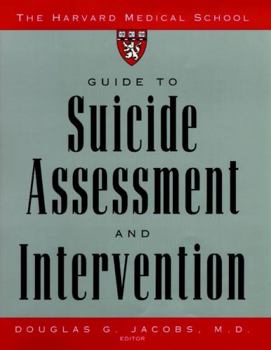The Harvard Medical School Guide to Suicide Assessment and Intervention
This vital resource--edited by Harvard Medical School's DouglasJacobs, a nationally recognized expert on suicide anddepression--is the definitive guide for helping mental healthprofessionals determine the risk for suicide and appropriateinterventions for suicidal or at-risk patients. Created primarilyfor mental health clinicians (with several chapters directed towardprimary care physicians), the book is a hands-on guide for thosewho are often the first line of defense for assessing if a patientor client is suicidal. Comprehensive in scope, the book offers a wealth of informationabout such useful topics as inpatient and outpatient issues, psychopharmacology, and advice about working with specialpopulations. Most importantly, the book's contributors detaileffective techniques for intervention and offer a model of suicideassessment that focuses on predisposing conditions, potentiatingconditions, and specific suicide inquiries. As a special feature, the book also includes a helpful section on contracts--agreementsmade with the patient not to harm themselves--and useful factsabout the subsequent liability issues. In addition, there is acompelling analysis of the controversial issues surroundingassisted suicide as well as an honest personal account ofsuicidality from a professional who has experienced it for herself.
Format:Hardcover
Language:English
ISBN:0787943037
ISBN13:9780787943035
Release Date:January 1999
Publisher:Jossey-Bass
Length:736 Pages
Weight:3.00 lbs.
Dimensions:2.2" x 7.2" x 9.4"
Customer Reviews
3 ratings
a must-have for every clinician's bookshelf
Published by Thriftbooks.com User , 15 years ago
This volume seeks to answer the essential question, "How can clinicians identify patients who may be at risk for suicide and take the necessary steps to reduce that risk?" It provides a comprehensive review of current thinking and evidence-based practice in the field of suicidology, with particular emphasis upon medical intervention. Great depth and breadth of information. For example, Part One (Assessment) covers the following topics: overview of suicide, recommended protocol, epidemiology, community approach, psychodynamic understanding of suicide, lethality assessment, neurobiology of suicidal behavior, profiles of completed suicides, murder-suicide, self-mutiliation, critical points in the assessment and management of suicide risk, etc. !) Part Two covers intervention and related diagnoses (trauma, bipolar do, borderline pdo, schizophrenia, lifetime suicide risk and affective disorders, etc.). Part Three covers special issues including children and adolescents, the elderly, contracting, suicide in medical settings, assessment in primary care settings, liability issues, and euthanasia/assisted suicide. An important resource for all mental health professionals.
fast service/ good book
Published by Thriftbooks.com User , 19 years ago
I WAS HAPPY THAT IT WAS SHIPPED SUPERFAST TO ME. THE BOOK WAS IN EXCELLENT CONDITION AND AM HAPPY WITH MY PURCHASE. I WOULD DO SERVICE WITH THIS SELLER AGAIN.
A "must" in all physicians library.
Published by Thriftbooks.com User , 25 years ago
This book helps professionals determine the risk level for suicidal or at-risk patients and recommends a suicide assessment protocal that can be effectively incorporated into clinical practice. The authors also provide guidelines for intervening when a person is at risk for harming himself or herself. If you're researching on suicide this is the right book to start reading. A "must" in all physicians library.





